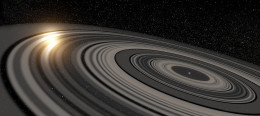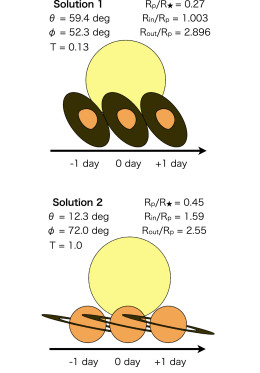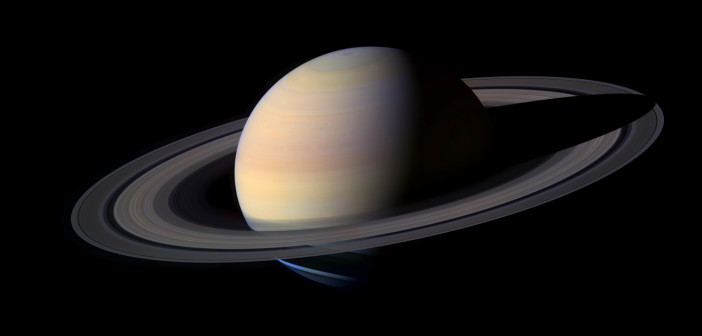Are planetary rings as common in our galaxy as they are in our solar system? A new study demonstrates how we might search for ringed exoplanets — and then possibly finds one!
Saturns Elsewhere?

Artist’s illustration of the super ring system around exoplanet J1407b. This is the only exoplanet we’ve found with rings, but it’s not at all like Saturn. [Ron Miller]
Have we not discovered ringed exoplanets just because they’re hard to identify? Or is it because they’re not out there? A team of scientists led by Masataka Aizawa (University of Tokyo) has set out to answer this question by conducting a systematic search for rings around long-period planet candidates.

The transit light curve of KIC 10403228, shown with three models: the best-fitting planet-only model (blue) and the two best-fitting planet+ring models (green and red). [Aizawa et al. 2017]
The Hunt Begins
Why long-period planets? Rings are expected to be unstable as the planet gets closer to the central star. What’s more, the planet needs to be far enough away from the star’s warmth for the icy rings to exist. The authors therefore select from the collection of candidate transiting planets 89 long-period candidates that might be able to host rings.
Aizawa and collaborators then fit single-planet models (with no rings) to the light curves of these planets and search for anomalies — curves that aren’t fit well by these standard models. Particularly suspicious characteristics include a long ingress/egress as the planet moves across the face of the star, and asymmetry of the transit shape.
After applying a series of checks to eliminate false positives, the authors are left with one candidate: KIC 10403228.
Rings or Not?

Schematics of the two best-fitting ringed-exoplanet models for KIC 10403228, and the possible parameters of the system. The planet crosses the disk of the star from left to right with a grazing transit. [Adapted from Aizawa et al. 2017]
The authors conclude by testing a variety of other scenarios that could explain the anomalies in the light curve instead. They find that two other scenarios are plausible: 1) the star is in an eclipsing binary system, with the second star surrounded by a circumstellar disk, and 2) the star is part of a hierarchical triple, and the transits are caused by a binary star system as it orbits KIC 10403228.
Though Aizawa and collaborators aren’t able to rule either of these other two scenarios out, they suggest that follow-up spectroscopy or high-resolution imaging may help distinguish between the different scenarios. In the meantime, their methodology for systematically searching for ringed exoplanets has proven worthwhile, and they plan to extend it now to a larger data set. Perhaps we’ll soon find other Saturn-like planets in our galaxy!
Citation
Masataka Aizawa (逢澤正嵩) et al 2017 AJ 153 193. doi:10.3847/1538-3881/aa6336


10 Comments
Pingback: The search for ringed exoplanets
Pingback: Astronomers Have Discovered Another Mysterious Dimming Star, And It's Even More Epic | Dose Of Viral
Pingback: Astronomers Have Discovered Another Mysterious Dimming Star, And It’s Even More Epic – Worthydose
Pingback: Astronomers have discovered another mysterious dimming star, and it's even more epic - Science News
Pingback: Astronomers have discovered another mysterious dimming star, and it's even more epic - Science Daily Press
Pingback: Astronomers Have Discovered Another Mysterious Dimming Star, And It's Even More Epic - Science News
Pingback: Astronomers Have Discovered Another Mysterious Dimming Star, And It's Even More Epic - The Best of Everything
Pingback: Astronomers have discovered another mysterious dimming star, and it's even more epic - Oni Science
Pingback: Astronomers Have Discovered Another Mysterious Dimming Star, And It's Even More Epic - Science News 24-7
Pingback: Astronomers Have Discovered Another Mysterious Dimming Star, And It's Even More Epic - Science News Hub